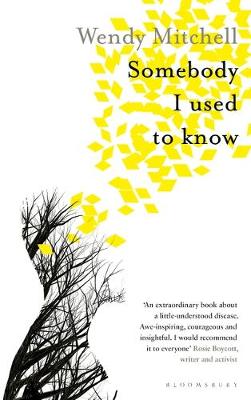Somebody I Used to Know
Mitchell W (2018), Bloomsbury, London, ISBN 978-1-4088-9386-4
Review by Trisha Dunning AM FACN (DLF)
 I am sitting in front of the consultant while he scribbles down the results of my latest memory tests. From the other side of the desk, I try and fail to read his writing. Finally he sits back and sighs.
I am sitting in front of the consultant while he scribbles down the results of my latest memory tests. From the other side of the desk, I try and fail to read his writing. Finally he sits back and sighs.
‘You’re a little bit worse than last time’ he says, and despite the fact I know I have a progressive illness, I feel my heart sink inside my chest.
I shuffle out of his office, feeling sad that my diseased brain has let me down yet again. I don’t know exactly where or how, on which part of the test or which specific questions. All I can remember is the word ‘worse,’ I go to sleep with the word ‘worse’ on the pillow beside me (P170).
Simple language with a powerful message about the effect of words.
The book, Somebody I Used to Know, should be required reading for all health professionals, not only those who work in aged care settings. The story is a simply told true account of Wendy Mitchell’s journey with dementia from her diagnosis at age 58 and the strategies she used to accept and live with dementia. The book was ghost written by Anne Whorton and is based on Wendy’s online blog: Which me am I today?
The book recounts Wendy’s attempts to hide her unexplained memory lapses from her work colleagues in the National Health Service in the UK before she was diagnosed – she was, after all the ‘go to’ person if there was a problem. The stress of having to stop activities that represented independence such as cooking, driving and running and find new ways of doing things is evident in her story. The story shows how her resourcefulness, her creative and extraordinary problem-solving skills, her resilience and positive thinking, despite her dementia, enabled her to live independently.
A poignant part of the story recounts Wendy’s careful planning to counter distress and embody happier times when she told her two daughters about her dementia and wrote her Advance Care Directive/Plan with them. She was adamant she did not want her daughters to care for her.
The story is one of hope and resilience amid periods of fear: There is so much sadness about the diagnosis of dementia that if you dwelled on the sadness all the time you’d simply end up depressed. It is not a depressing story.
Wendy joined Alzheimer’s groups, participated in an Alzheimer’s research, trained as an Alzheimer’s champion, spoke to groups and gave radio and TV interviews. She reviewed Still Alice and attended the London première of the movie where she met the actress, Juliette Moore, who played Alice.
Juliette asked Wendy How did I do? Wendy indicated You got it right – the fog descending over your eyes is exactly how I felt. In some ways, Wendy’s story echoes many of Alice’s experiences, although Still Alice is a fictional but very real story about Alice, a linguistics professor, who also developed early onset dementia. Still Alice, written by Lisa Genova, a neuroscientists, should also be required reading for health professionals.
Research suggests reading literary fiction such as Still Alice builds Theory of Mind. Theory of Mind refers to the cognitive capacity to understand one’s own and other people’s mental states. Reading narrative fiction enhances theory of mind (Kidd and Castano 2013). Reading true stories is likely to be an even more powerful stimulus to theory of mind, especially a book like Somebody I Used to Know.
Lessons for health professionals
- The diagnosis of Alzheimer’s is not the end. There is a beginning, a middle and an end. A lot can happen between the beginning and the end.
- It is important to use positive language and focus on what the person can do rather than what they can no longer do.
- People with dementia may have similar symptoms and eventual outcomes, but they are unique and have different life stories, experiences and needs. They require personalised care.
Reference:
Kidd D, Costano E. (2013) reading literary fiction improves theory of mind. Science Express htt://www.sciencemag.org/content/early/recent/3 October 2013/Page 1/10.1126/science.1239918





